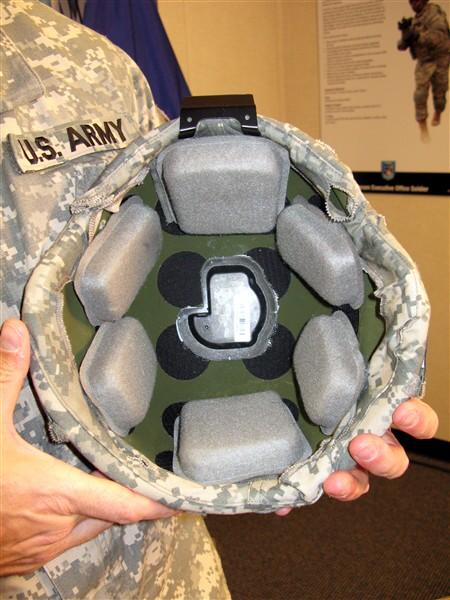![]() 1st Battalion 22nd Infantry
1st Battalion 22nd Infantry ![]()
Raider Brigade receives new helmet sensors
February 2008
Raider Brigade Soldiers first to field new HEADS Sensors
New technology to make future helmets safer
Spc. David Hodge
1st BCT PAO, 4th Inf. Div.
FORT
HOOD, Texas – Soldiers of the 1st Brigade Combat Team will
be among the first units of the 4th Infantry Division
to receive the Head-born Energy Analysis and Diagnostic System
Sensor and begin fielding the new technology while deployed to
Baghdad.
The sensor mounted inside the Army’s Advanced Combat Helmet
will be worn by Raider Brigade Soldiers
throughout their 15-month deployment in support of Operation
Iraqi Freedom.
The
technology surrounding the ballistic helmet is continually
improved to lessen the trauma caused by cranial impacts that
Soldiers face
while operating on today’s battlefield, said Lt. Col. Rick
Caya, executive officer, 1st BCT, 4th Inf. Div.
(Editor's note: LTC Rick Caya was S-3 and XO of 1-22 during OIF 1, and Rear Detachment CO of 1BCT during OIF 05-07)
“The sensors help improve treatment of head injuries and development of next-generation combat helmets,” Caya said.
The latest addition to the ACH will contribute to lessening the impact on Soldiers in the future, he added.
“The sensors
provide the ability to help the U.S. Army improve a
Soldier’s individual equipment system,”
stated Caya, who hails from Waterloo, Iowa.
“It’s a great opportunity to provide downrange feedback for the U.S. Army,” he said.
Although the sensors are not going to directly affect 1st BCT
Soldiers during the deployment,
the sensors will benefit future units by aiding researchers in
developing better equipment and technology
to assist Soldiers in combat, explained Caya.
“If the Raider Brigade can help in that advancement process in any way, that would be great for Soldiers,” he added.
The six-ounce HEADS sensor is a small, undetectable piece of
microchip technology surrounded by thin plastic composite
that records traumatic disturbances to the helmet, said Caya.
The HEADS sensor fits neatly under the crown pad of the ACH and
contains a three-axis accelerometer and pressure sensor
that detects sudden movements and percussion, explained Caya.
“We
asked ourselves: ‘How can we make a better helmet to save
the Soldier?” stated Steve Motoyama,
the program manager for the company that designed the sensors.
“The HEADS sensors will provide a good opportunity to make future helmets safer,” he added.
The 1st BCT is one of the first units in the U.S. Army to field
the electronic technology in Iraq.
These efforts ensure that future Soldiers remain the best
equipped and best trained Soldiers in the world.
FORT HOOD, Texas – Spc. Jessica Sands, a petroleum supply specialist from Dayton, Ohio, Company A, 4th Support Battalion, 1st Brigade Combat Team, 4th Infantry Division, uses a pair of pliers to pull out existing hook-pile fastener pads out of the Advanced Combat Helmet to make room for the Head-born Energy Analysis and Diagnostic System Feb. 26 at Fort Hood’s Raider Physical Fitness Center. (U.S. Army photo by Spc. David Hodge, 1st BCT PAO, 4th Inf. Div.) |
 The internally mounted HEADS sensor for
the Photo by Donna Miles
|
Home | Photos | Battles & History | Current |
Rosters & Reports | Medal of Honor | Killed
in Action |
Personnel Locator | Commanders | Station
List | Campaigns |
Honors | Insignia & Memorabilia | 4-42
Artillery | Taps |
What's New | Editorial | Links |